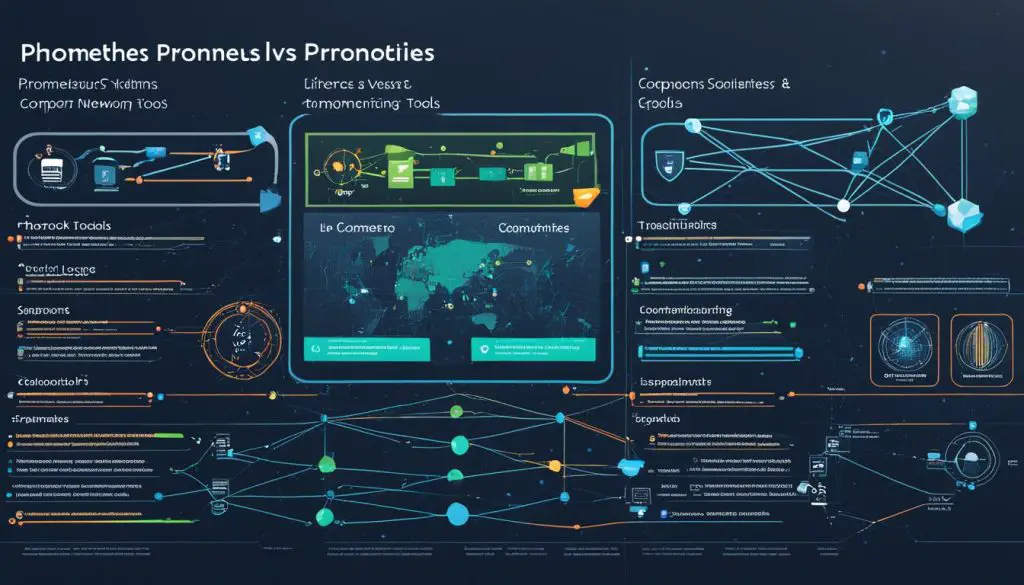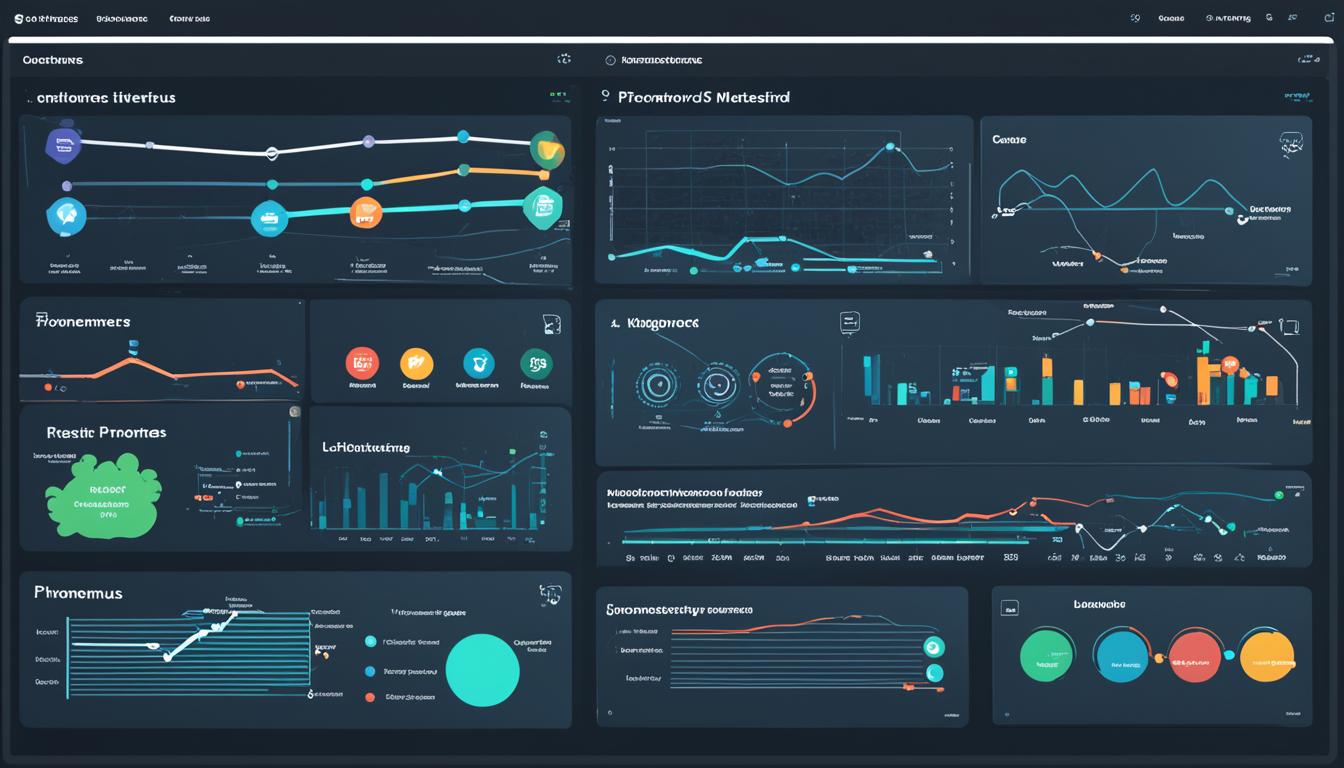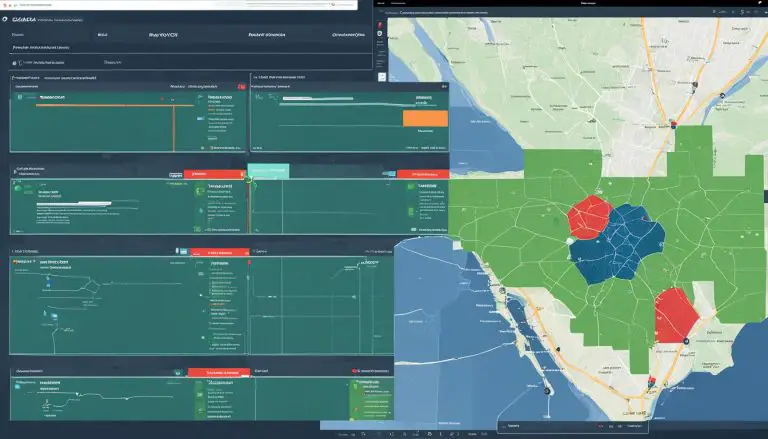Prometheus vs. LibreNMS: Choosing Your Monitoring Tool
Are you struggling to choose the perfect network monitoring tool for your organization? With so many options out there, it can be challenging to determine which one will best meet your needs. But fear not! In this article, I will compare Prometheus and LibreNMS, two popular open-source network monitoring tools, giving you a comprehensive insight into their features, advantages, and disadvantages. So, are you ready to dive into the world of network monitoring?
Key Takeaways:
- Network monitoring tools are crucial for maintaining a live and optimized network.
- Prometheus and LibreNMS are two popular open-source monitoring tools worth considering.
- Each tool has its own set of advantages and disadvantages, so it’s important to understand them before making a decision.
- Factors such as performance metrics, alerting capabilities, visualization, and community support should be considered in your evaluation.
- Ultimately, choosing the right tool depends on your specific network monitoring needs.
Why Do You Need a Network Monitoring Tool?
Network monitoring tools are vital for maintaining the optimal performance of your network. They play a crucial role in detecting and addressing performance issues in a timely manner, ensuring that your network functions smoothly.
One of the key benefits of network monitoring tools is their ability to prevent security breaches. By continuously monitoring your network, these tools can identify any suspicious activity or potential threats, allowing you to take immediate action and strengthen your network’s security defenses.
In addition to security, network monitoring tools are essential for minimizing downtime. They help you identify bottlenecks, congestion, or any other factors that may lead to service disruptions or slowdowns. By proactively addressing these issues, you can prevent network downtime and ensure uninterrupted operations.
Furthermore, network monitoring tools enable you to optimize network performance. By monitoring key performance metrics such as bandwidth utilization, latency, and packet loss, you can identify areas for improvement and fine-tune your network for better efficiency.
With network monitoring tools, you gain valuable insights into your network’s activity. They allow you to autodiscover devices, view performance data, and analyze network traffic. This helps you understand how your network is utilized, detect potential inefficiencies or congestion points, and make data-driven decisions to optimize performance.
Network monitoring tools are essential for maintaining a live network and ensuring optimal performance.
Overall, network monitoring tools offer several benefits, including:
- Detecting and addressing performance issues
- Preventing security breaches
- Minimizing downtime
- Optimizing network performance
- Autodiscovering devices
- Viewing performance data
- Configuring alerts
- Analyzing network activity
By leveraging the power of network monitoring tools, you can ensure the stability, security, and efficiency of your network, ultimately contributing to the overall success of your business or organization.
Overview of Prometheus
Prometheus is an open-source network monitoring tool specifically designed for monitoring time-series data. It offers a wide range of features that make it a powerful choice for both small and large organizations.
One of Prometheus’ key strengths is its ability to collect and store time-series data, allowing users to monitor and analyze performance metrics over time. This makes it particularly useful for observing trends and identifying potential issues before they become critical.
With Prometheus, you can easily configure alerting rules to receive notifications when certain thresholds are exceeded or anomalies are detected. This proactive approach helps ensure that you can address issues promptly and minimize downtime.
Another valuable feature of Prometheus is its integration with Grafana, a popular data visualization tool. This integration allows you to create visually appealing and interactive dashboards that provide real-time insights into your network’s performance. With the flexibility provided by Grafana, you can customize your dashboards to suit your specific monitoring needs.
Grafana Integration
The integration between Prometheus and Grafana offers a seamless experience for visualizing your network monitoring data. Grafana’s robust set of features and plugins allow you to create dynamic and interactive dashboards that provide detailed insights into your network’s performance.
By connecting Prometheus and Grafana, you can access a wide range of visualization options, including charts, graphs, tables, and heatmaps. These visualizations help you understand complex time-series data and identify patterns or anomalies that require attention.
Furthermore, Grafana allows you to create custom alerts and notifications based on the data collected by Prometheus. You can set up alerting rules to trigger notifications via email, slack, or other communication platforms whenever specified conditions are met. This ensures that you are promptly informed about any critical events or issues in your network.
“The combination of Prometheus and Grafana provides a powerful and flexible solution for monitoring and visualizing time-series data. It empowers organizations to gain deeper insights into their network’s performance and make informed decisions based on real-time information.”
With its open-source nature, Prometheus also benefits from an active and supportive community. This community-driven development ensures regular updates, bug fixes, and the availability of additional features and integrations.
Overall, Prometheus is a robust open-source network monitoring tool that excels in capturing and analyzing time-series data. Its alerting capabilities, integration with Grafana, and strong community support make it an ideal choice for organizations that require comprehensive monitoring and analysis of their network performance.
Overview of LibreNMS
LibreNMS is an open-source network monitoring and autodiscovery tool that provides comprehensive monitoring capabilities for a wide range of network devices. With its user-friendly interface and robust features, LibreNMS is a popular choice among network administrators.
One of the key strengths of LibreNMS is its autodiscovery functionality, which allows for effortless device discovery and monitoring. It supports monitoring various devices, including routers, switches, servers, and wireless controllers, making it suitable for networks of all sizes.
LibreNMS offers intuitive dashboards that provide a holistic view of your network’s performance. These dashboards enable you to monitor various network metrics, such as bandwidth utilization, CPU usage, and interface status, at a glance, ensuring you stay informed about network health.
In addition to its intuitive dashboards, LibreNMS also boasts powerful graphing capabilities. These capabilities allow you to visualize historical and real-time data, making it easier to analyze trends, identify anomalies, and troubleshoot network issues effectively.
With alerting capabilities built into LibreNMS, you can set up customizable alerts to receive notifications when specific network conditions or thresholds are met. This ensures that you are promptly alerted to any potential issues, enabling you to take proactive measures and prevent any disruptions to network performance.
LibreNMS is built on the foundations of Observium, another popular network monitoring tool. Its open-source nature allows for easy customization and integration with other technologies in your network infrastructure. This flexibility makes LibreNMS adaptable to your specific monitoring requirements.
Overall, LibreNMS provides a powerful and user-friendly solution for open-source network monitoring. Its autodiscovery feature, intuitive dashboards, graphing capabilities, and customizable alerts make it a valuable tool for network administrators seeking a comprehensive monitoring solution.
LibreNMS offers intuitive dashboards, powerful graphing capabilities, and customizable alerts, making it a valuable tool for network administrators seeking a comprehensive monitoring solution.
Continue reading to learn about the advantages of Prometheus in the next section.
Prometheus Advantages
When it comes to network monitoring tools, Prometheus offers numerous advantages that set it apart from other options. Its focus on time-series data monitoring allows for in-depth analysis and a comprehensive understanding of your network’s performance metrics. By collecting and storing data over time, Prometheus enables you to track trends, identify anomalies, and make data-driven decisions to optimize your network’s performance.
One of the key benefits of Prometheus is its integrated alerting system. With Prometheus, you can set up custom alerts based on specific metrics or thresholds, ensuring that you are quickly notified of any issues or anomalies within your network. This proactive approach helps you address potential problems before they escalate, minimizing downtime and improving overall network reliability.
Furthermore, Prometheus has a large and vibrant community of users and developers who provide extensive support and resources. This community-driven development ensures that Prometheus is constantly evolving and improving, with regular updates and new features. Whether you need assistance, want to share insights, or seek guidance on best practices, the Prometheus community is there to help and support you.
Prometheus excels in time-series data monitoring and alerting, making it a powerful tool for network monitoring and performance optimization.
Overall, Prometheus offers significant advantages for organizations of all sizes. Its focus on time-series data monitoring, integrated alerting system, and strong community support make it an ideal choice for those seeking a flexible and powerful network monitoring solution.
LibreNMS Features
LibreNMS offers a range of powerful features that make it an excellent choice for network monitoring and management.
Autodiscovery
One of LibreNMS’s standout capabilities is its autodiscovery feature. This simplifies the process of adding devices to the network monitoring system. With autodiscovery, LibreNMS can automatically detect and add network devices, saving time and effort for administrators.
Intuitive Dashboards
LibreNMS provides intuitive dashboards that offer a comprehensive view of network performance. These visually appealing dashboards display key metrics and performance data in a user-friendly and easy-to-understand format. Administrators and IT teams can quickly identify any issues or anomalies, enabling proactive troubleshooting and maintenance.
Customizable Graphing
Another notable feature of LibreNMS is its customizable graphing capabilities. The tool allows users to create custom graphs and charts to visualize network performance data. This flexibility empowers administrators to analyze specific metrics and track performance trends over time. With customizable graphing, IT teams can gain deeper insights into network behavior and make informed decisions.
Alerting and Monitoring
LibreNMS also offers robust alerting and monitoring functionalities. It can generate alerts based on predefined thresholds or specific events, ensuring that IT teams are promptly notified of any network issues or potential failures. Additionally, LibreNMS can monitor various network devices, including routers, switches, servers, and wireless controllers, providing comprehensive visibility into the network infrastructure.
Overall, LibreNMS combines autodiscovery, intuitive dashboards, customizable graphing, and advanced alerting to provide a comprehensive network monitoring solution. Its user-friendly interface and powerful features make it a popular choice among IT professionals for effectively managing and optimizing network performance.
Prometheus vs. LibreNMS Comparison
When comparing Prometheus and LibreNMS, it’s essential to evaluate their key features and advantages. Both network monitoring tools serve distinct purposes and cater to different monitoring needs.
-
Data Monitoring
Prometheus excels in time-series data analysis, making it ideal for monitoring and collecting performance metrics. Its robust querying capabilities allow for in-depth analysis and understanding of network behavior. On the other hand, LibreNMS offers comprehensive network monitoring capabilities, enabling you to monitor a wide range of devices and receive real-time performance data.
-
Alerting
Both Prometheus and LibreNMS provide alerting functionalities to notify network administrators about critical events. While Prometheus has a strong focus on alerting, allowing you to set up complex alert rules and notifications, LibreNMS offers customizable alerting capabilities tailored to your specific network monitoring requirements.
-
Visualization
Prometheus integrates seamlessly with Grafana, a leading data visualization platform, providing advanced data visualization and dashboards. This integration offers extensive graphing capabilities and enables you to create visually appealing representations of your network performance. On the other hand, LibreNMS provides intuitive and customizable dashboards within its platform, allowing you to visualize network data effortlessly.
-
Community Support
Prometheus boasts a large and active community, making it easy to seek assistance, find resources, and learn from experienced users. The community-driven development ensures that the tool continuously evolves and improves. Similarly, LibreNMS has an engaged community that actively contributes to its development and provides valuable insights and support.
Ultimately, the choice between Prometheus and LibreNMS depends on your organization’s specific network monitoring requirements and preferences. Consider the nature of your network, the metrics you need to monitor, and the level of customization and scalability required. Evaluating these factors will help you select the most suitable network monitoring tool for your needs.

Choosing the Right Monitoring Tool
When it comes to selecting the perfect monitoring tool for your network, there are several factors you need to consider. By evaluating these key elements, you can ensure that the chosen tool aligns perfectly with your performance tracking needs, providing you with valuable insights and metrics to optimize your network’s efficiency. Here are the factors to ponder:
Specific Requirements of Your Network
Every network is unique, with its own set of requirements and challenges. Consider the size, complexity, and nature of your network infrastructure. Do you need to monitor a small home network or a large enterprise network with multiple locations? Understanding the specific needs of your network will help you narrow down the options and choose a monitoring tool that can effectively handle those requirements.
Level of Customization Required
Not all monitoring tools offer the same level of customization. Evaluate how much flexibility and control you need over the monitoring process. Some tools provide extensive customization options, allowing you to tailor the monitoring dashboard and alerts to your preference. Others may have more limited customization capabilities. Assess your customization needs to find a tool that suits your monitoring goals.
Complexity of Your Infrastructure
The complexity of your network infrastructure can influence your monitoring tool choice. If you have a complex network with various devices and protocols, you may need a tool that can handle the intricacies and provide comprehensive monitoring capabilities. On the other hand, if your network is relatively simple, a less complex monitoring tool might suffice.
Community Support
Community support is crucial when selecting a monitoring tool. A vibrant and active community can provide valuable resources, troubleshooting assistance, and updates to enhance the tool’s functionality. Research the community surrounding each tool you are considering and determine the level of support they offer. A robust community can significantly contribute to your success in utilizing the monitoring tool effectively.
By carefully evaluating these factors, you can make an informed decision while selecting a monitoring tool that meets your specific requirements. Remember to take your network’s complexity, customization needs, and the available community support into account. Choosing the right monitoring tool is essential to enhance your network’s performance tracking and ensure a seamless experience for your users.
Popular Open-Source Network Monitoring Tools
When it comes to network monitoring, Prometheus and LibreNMS are not the only options available. There are several other popular open-source network monitoring tools that can meet your needs. These tools include Cacti, Nagios Core, Icinga 2, and Zabbix.
Cacti: Cacti is a powerful network monitoring tool known for its ability to graph network bandwidth usage. It provides a user-friendly interface and customizable graphs, making it easy to monitor network performance.
Nagios Core: Nagios Core is a robust open-source solution that offers comprehensive monitoring capabilities. With Nagios Core, you can monitor network services, host resources, and system metrics. It also provides alerting functionality to keep you informed of any issues.
Icinga 2: Icinga 2 is a scalable and extensible network monitoring tool. It allows you to monitor the availability and performance of network services, applications, and infrastructure components. Icinga 2 provides a powerful rule-based configuration system and supports automation and high availability.
Zabbix: Zabbix is a versatile network monitoring tool that offers a wide range of features. It provides real-time monitoring, alerting, and visualization capabilities. With Zabbix, you can monitor network devices, servers, and applications, and gain valuable insights into their performance.
Each of these tools has its own strengths and features. When evaluating network monitoring solutions, consider factors such as scalability, ease of use, customization options, and community support. Choosing the right tool for your needs will help you effectively monitor your network and ensure optimal performance.
Now that you are familiar with popular open-source network monitoring tools, let’s explore the benefits of using these open-source solutions in the next section.
Benefits of Open-Source Monitoring Tools
Open-source network monitoring tools offer a wide range of benefits that make them an excellent choice for network monitoring needs. Whether you are managing a small home network or a large enterprise infrastructure, these tools provide the flexibility, customization, and cost-effectiveness that you require.
Flexibility
One of the key advantages of open-source network monitoring tools is their flexibility. They are designed to adapt to the unique requirements of your network, allowing you to customize and configure them according to your specific needs. You have the freedom to modify the software to meet your monitoring goals, whether it’s monitoring certain performance metrics or integrating with other tools in your network ecosystem.
Customization
With open-source monitoring tools, you can tailor the software to suit your monitoring preferences. You have access to the source code, enabling you to make modifications and enhancements to meet your specific monitoring requirements. Whether it’s creating custom dashboards, implementing new alerting mechanisms, or integrating with other systems, open-source tools provide the flexibility to customize the monitoring solution to your exact needs.
Cost-effectiveness
Open-source network monitoring tools are cost-effective options for organizations of all sizes. They eliminate the need for expensive proprietary software licenses, allowing you to allocate your budget to other critical areas of your network infrastructure. Open-source tools also often have active communities, which means you can access support, documentation, and updates without additional costs. This cost-saving aspect makes open-source monitoring tools particularly attractive for home network monitoring setups.
Open-source network monitoring tools provide a cost-effective way to monitor and manage networks, making them an excellent choice for home network monitoring setups.
In conclusion, open-source network monitoring tools offer flexibility, customization, and cost-effectiveness, making them ideal choices for any network monitoring needs. Whether you are monitoring a small home network or managing a large enterprise infrastructure, these tools empower you to monitor and manage your network effectively, while allowing you to tailor the software to your specific requirements.
Conclusion
After comparing Prometheus and LibreNMS, it is evident that both network monitoring tools offer powerful features and capabilities. When selecting the right tool for your network, it is crucial to consider your specific requirements, the level of customization needed, and the available support.
Prometheus is an excellent choice if you require in-depth monitoring and analysis of time-series data. Its integration with Grafana provides advanced data visualization options. The large Prometheus community ensures plenty of support and resources for users.
LibreNMS stands out with its comprehensive network monitoring capabilities and intuitive dashboards. It offers autodiscovery, customizable graphing, and alerting features. If you are looking for a tool that simplifies device management and monitoring, LibreNMS is a solid option.
Ultimately, the choice between Prometheus and LibreNMS depends on your specific performance tracking needs. Consider the unique requirements of your network and evaluate which tool aligns best with those needs.
Choosing the Right Monitoring Tool
When choosing a network monitoring tool, it is essential to take the following factors into account:
- The specific requirements of your network.
- The features and capabilities offered by each tool.
- The level of customization and support available.
By evaluating these factors, you can make an informed decision about which tool will effectively meet your performance tracking needs.
Note: The image above captures the essence of choosing the right network monitoring tool, symbolizing the decision-making process and the options available.
While Prometheus and LibreNMS have been the primary focus of this comparison, it’s essential to explore other popular open-source network monitoring tools such as Cacti, Nagios Core, Icinga 2, and Zabbix. Each tool has its own unique strengths and features, offering different solutions for network monitoring and management.
For further reading and information on network monitoring, performance tracking, and best practices, there are plenty of additional resources available. Dive deeper into articles, tutorials, and documentation to enhance your understanding and optimize your network monitoring efforts.
What to Read Next
Now that you have gained a better understanding of network monitoring tools, it’s time to explore additional resources to expand your knowledge further. There are numerous articles, tutorials, and documentation available that delve deeper into network monitoring tools, performance tracking, and best practices.
By continuously learning and staying updated, you can optimize your network monitoring efforts and ensure the smooth operation of your network. Dive into the wealth of network monitoring resources to discover new insights, strategies, and techniques.
Whether you are looking for specific information on network monitoring tools or seeking to enhance your overall understanding of network monitoring, additional reading can provide you with the in-depth knowledge you need. Take advantage of the vast array of resources available to stay informed and make informed decisions regarding your network monitoring strategy.
Remember, network monitoring is an ongoing process, and staying informed is crucial to maintaining a healthy and reliable network. By exploring additional reading materials, you can stay ahead of the curve and leverage the full potential of network monitoring tools.
FAQ
What are the benefits of using network monitoring tools?
What is Prometheus?
What is LibreNMS?
What advantages does Prometheus offer?
What features does LibreNMS have?
How do Prometheus and LibreNMS compare?
How should I choose the right monitoring tool?
What are some popular open-source network monitoring tools?
What are the benefits of open-source monitoring tools?
What should I read next to learn more about network monitoring?
Source Links
- https://opensource.com/article/19/2/network-monitoring-tools
- https://boniyeamin.medium.com/open-source-network-monitoring-tools-for-home-lab-7b2916672918
- https://www.scalahosting.com/blog/top-monitoring-tools-you-need-for-your-vps/
- About the Author
- Latest Posts
Janina is a technical editor at Text-Center.com and loves to write about computer technology and latest trends in information technology. She also works for Biteno.com.






